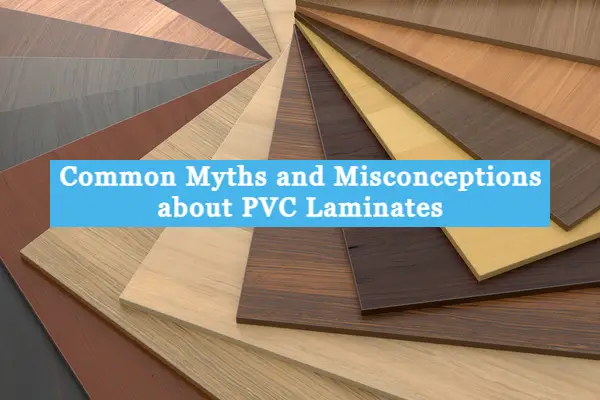Polyvinyl chloride (PVC) laminates are commonly used in the construction and furniture industries for their durability, versatility, and cost-effectiveness. However, there are several common myths and misconceptions surrounding PVC laminates. This article will address a few common ones and provide accurate information to dispel these misconceptions.
Myth 1: PVC laminates are toxic
One of the most general misconceptions is that polyvinyl chloride laminates are toxic and emit harmful chemicals. While it’s true that PVC contains chlorine, which can release toxic gases when burned, properly manufactured and installed, they do not pose a significant health risk. They undergo a rigorous manufacturing process that involves the addition of stabilisers, such as lead, to ensure their stability and safety. These stabilisers are tightly bound within their matrix, minimising the risk of leaching or off-gassing.
These laminates, applied in construction and furniture industries, comply with rigorous standards such as those set by the ASTM and EN, guaranteeing their safety and alignment with health regulations. It’s crucial to remember that appropriate use and disposal are necessary to mitigate potential risks.
Myth 2: They are not environmentally friendly
PVC has received criticism for its environmental impact, mainly due to its production process and non-biodegradable nature. However, it’s essential to differentiate between its production and its use. Its environmental concerns primarily stem from the manufacturing and disposal stages.
During the manufacturing process, steps can be taken to minimise environmental impact. Many manufacturers have adopted eco-friendly practices, such as using recycled PVC or implementing closed-loop systems to reduce waste generation. Additionally, advancements in production technology have led to the development of low-emission sheets, which have significantly reduced volatile organic compound (VOC) emissions.
Regarding disposal, while polyvinyl chloride is not biodegradable, it can be recycled. The laminates can be reused or reprocessed into other products, reducing environmental impact. Recycling programs and initiatives are increasingly being implemented to ensure responsible disposal and minimise waste.
Myth 3: Laminates are not durable
Another common misconception is that polyvinyl chloride laminates are not durable and prone to damage. However, they are renowned for their durability and resistance to wear and tear. They are highly resistant to moisture, scratches, stains, and fading, making them suitable for many applications, including high-traffic areas.
Read Also- 5 Common Fence Installation Errors and How to Avoid Them
These coverings have a protective wear layer that provides excellent resistance to daily use and ensures longevity. Additionally, they offer effortless cleaning and maintenance, requiring minimal care to maintain their optimal appearance. Regular cleaning with a mild detergent and soft cloth is usually sufficient to remove dirt and maintain the laminate’s appearance.
Myth 4: They have limited design options
Contrary to what some individuals believe, a product like the PVC laminate sheet offers far from limited design options and does not lack aesthetic appeal. Over the years, the laminates have undergone significant advancements in design versatility. They are available in many colours, patterns, textures, and finishes, providing limitless design possibilities.
Manufacturers utilise advanced printing techniques to achieve realistic patterns on PVC laminate sheets, effectively emulating the aesthetic of natural materials such as wood, stone, and metal. Moreover, these laminates can be embossed or textured to offer a tactile experience that further enhances the overall aesthetic appeal. So, whether you’re seeking a sleek, modern design or a warm, rustic look, they present a broad spectrum of options to accommodate various styles and preferences.
Conclusion
PVC laminates have been the subject of various myths and misconceptions, but it’s crucial to separate fact from fiction. These laminates are not inherently toxic or environmentally unfriendly when adequately manufactured, installed, and disposed of responsibly. They offer durability, a wide range of design options, and ease of maintenance. Users can make informed decisions and appreciate their benefits in construction and furniture applications by understanding accurate information about these laminates.




